Affiliate links on Android Authority may earn us a commission. Learn more.
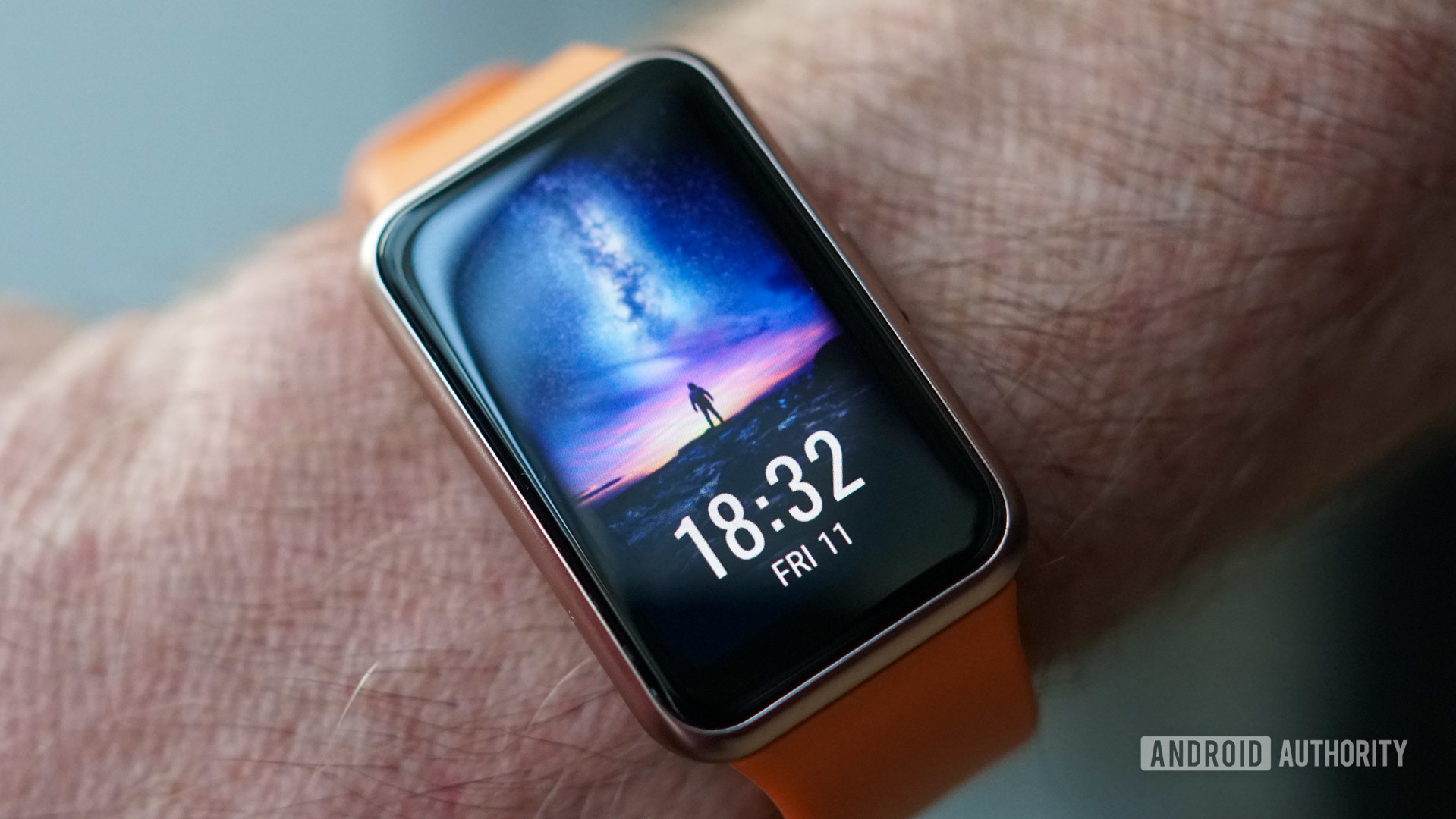
HUAWEI Watch Fit review: Cheaper, lighter, leaner
September 11, 2020
Huawei Watch Fit
What we like
What we don't like
Huawei Watch Fit
The HUAWEI Watch Fit looks like what you’d get if you threw a HUAWEI Band 4 Pro and a HUAWEI Watch GT 2 into an Apple Watch blender. It’s arguably a more fashion-forward wearable than a traditional fitness tracker or standard smartwatch, but it still packs enough smarts to fit in the “HUAWEI Watch” line rather than the “HUAWEI Band” family.
I’ve been wearing the HUAWEI Watch Fit alongside the new “regular” smartwatch from HUAWEI, the Watch GT 2 Pro. The dual-wearable experience provided some interesting insights we’ll dive into more in our full HUAWEI Watch Fit review below. A spoiler: unless you really want wireless charging or titanium, sapphire glass, and ceramic on your wrist, the HUAWEI Watch Fit will serve most of your fitness tracking needs just fine for 200 bucks less.
HUAWEI Watch Fit design
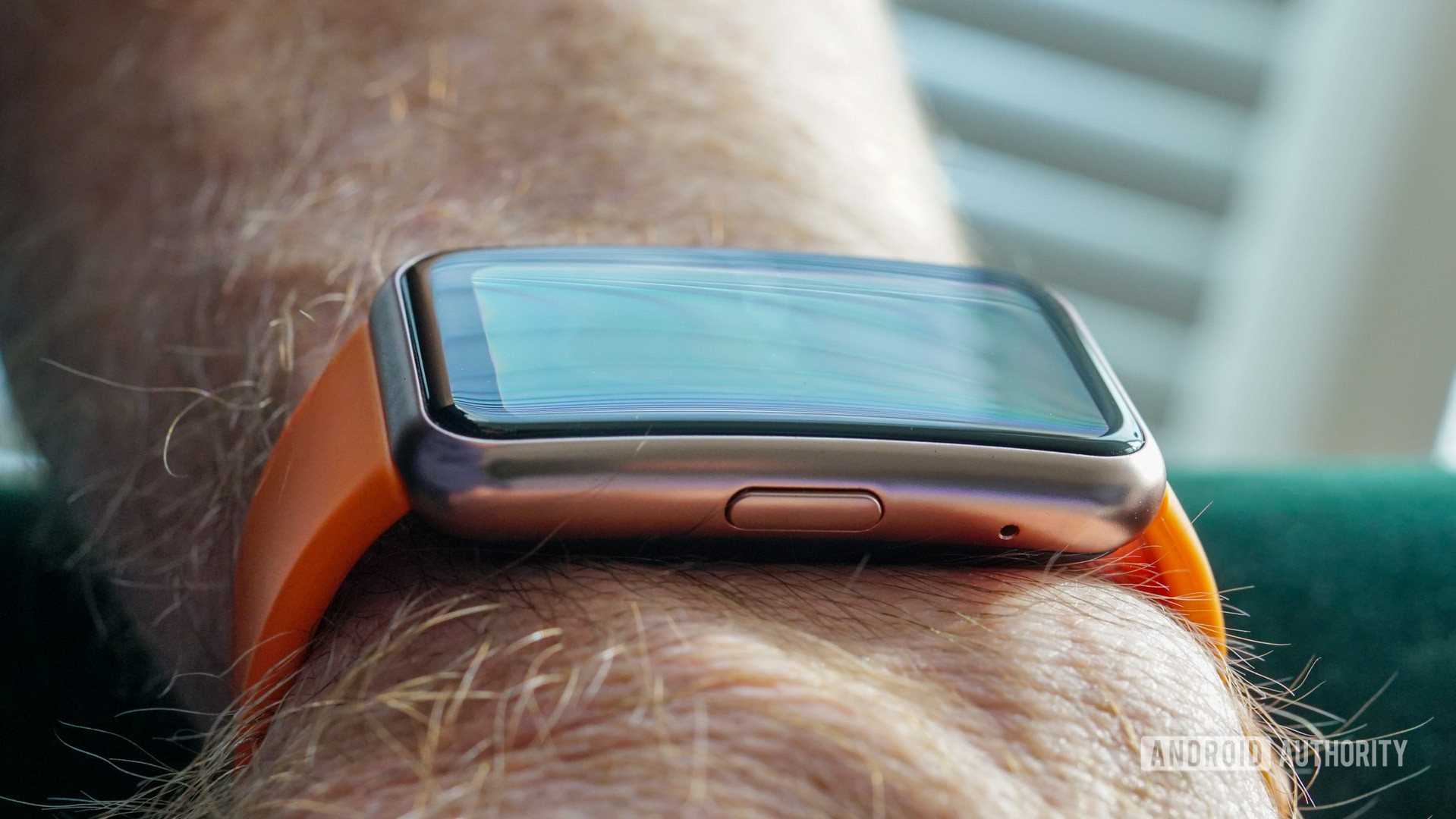
Yes, the HUAWEI Watch Fit looks like a stretched-out, skinny Apple Watch. Sadly, this is an all-too-common design choice at cheaper ends of the wearable spectrum where recognizability trumps uniqueness. I would have hoped HUAWEI would be beyond Apple-emulation by this point in the company’s storied history but it is what it is, so let’s just note it and move on.
The diminutive appeal of the HUAWEI Watch Fit is not lost on me.
The HUAWEI Watch Fit will instantly appeal to those who generally like HUAWEI’s wearable offerings but aren’t into the bulkiness of them. I’m a fan of a chunky watch personally, but the diminutive appeal of the HUAWEI Watch Fit is not lost on me. One thing I immediately noticed is that the Watch Fit doesn’t get caught on t-shirts like my other smartwatches because there are no big buttons on the side.
Read more: The best fitness trackers
Hardware
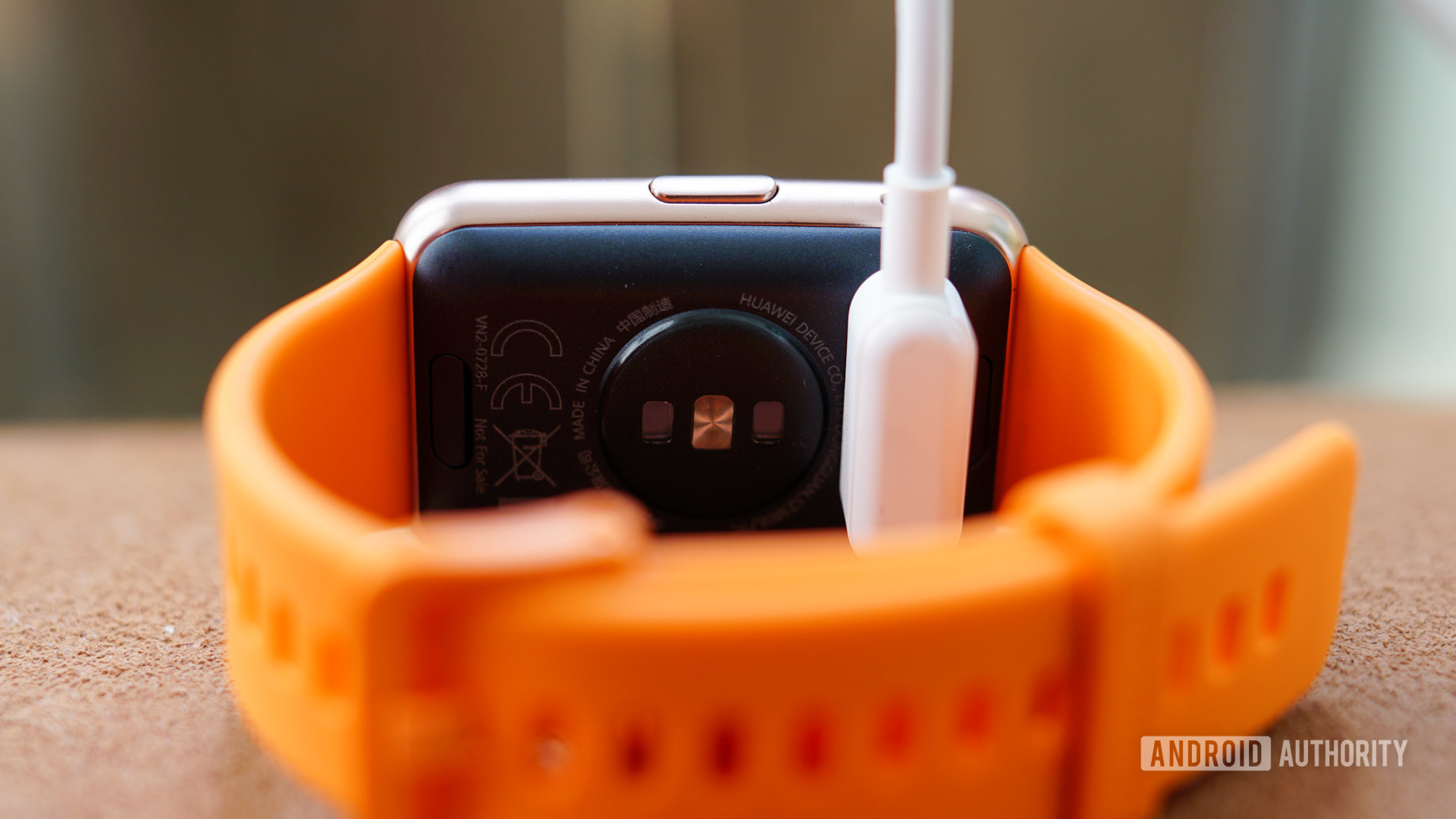
You’ll find a single flat button on the right-hand side, and a proprietary magnetic pogo pin integrated into the USB charging cable, so be careful you don’t lose or break it if you decide to buy a HUAWEI Watch Fit. It connects to one side of the plastic back of the Watch Fit, right next to the heart-rate sensor. In case you’re wondering, yes, you can charge your Watch Fit while wearing it and still track your heart rate, get an SpO2 measurement, or monitor your stress.
Throughout this review you’ll be seeing what I consider the best color of the bunch, the eye-catching Cantaloupe Orange paired with a rose gold chassis. The Watch Fit also comes in versions with a Sakura Pink strap (rose gold body), Graphite Black band (black body), and Mint Green watch strap (silver body). The HUAWEI Watch Fit chassis is made of a polymer material with a matte look.
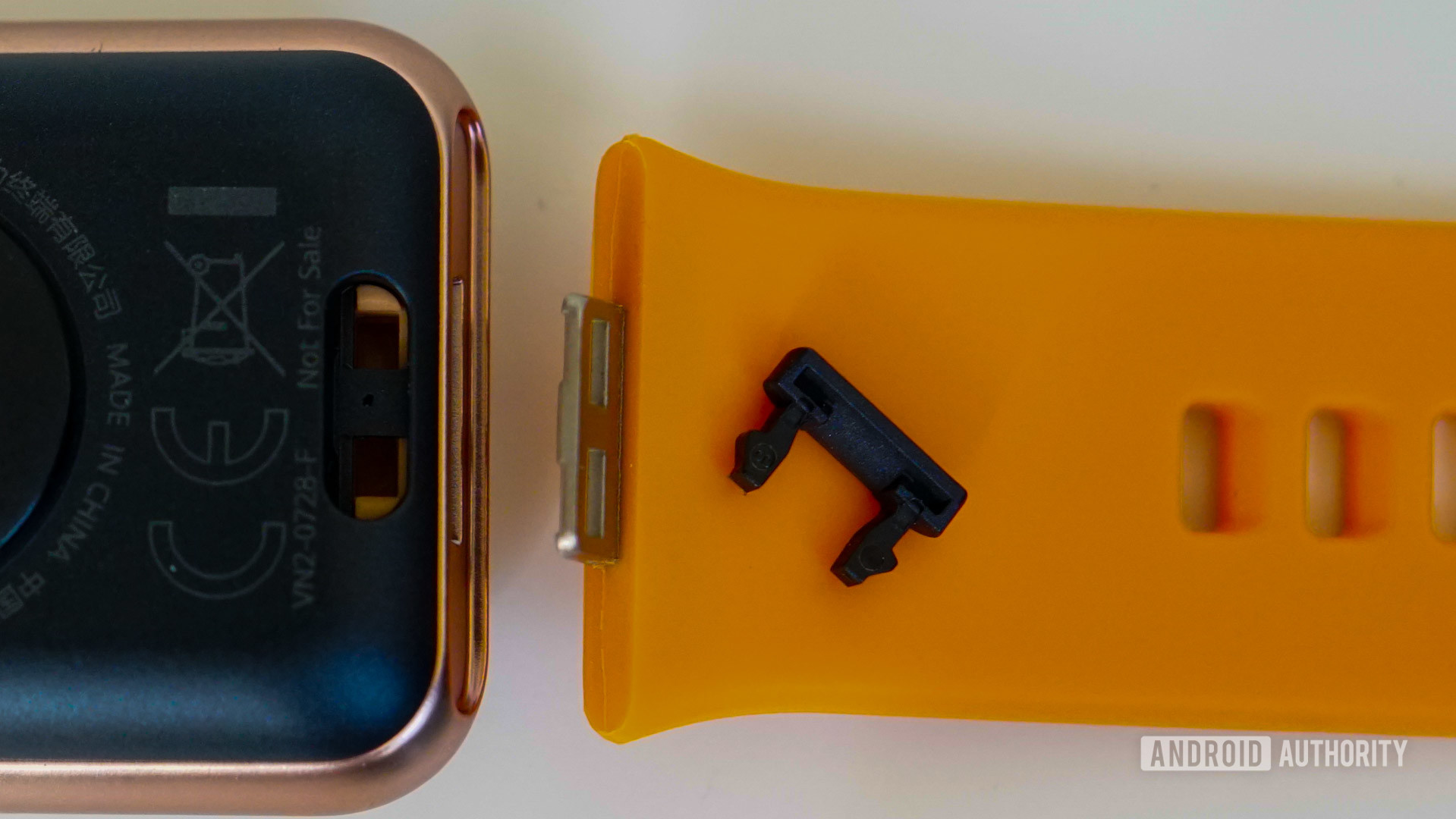
The simple silicone strap can be popped off by poking a fingernail into a little groove in the back to remove a plug that locks the strap in place. Unless you want to buy another official strap you’d best not lose the little locking plug because you can’t just throw another standard strap on the Watch Fit. It’s still early days, but this plastic locking mechanism doesn’t fill me with confidence.
The Watch Fit is super light, at just 34 grams (21 grams without the strap).
Display
The ever-so-slightly curved 1.64-inch OLED screen does a good job of fitting in all the same information a circular smartwatch does, but it does feel a little bit cramped at times. This is particularly noticeable on the screens that display heart rate or stress levels. You get used to it after a while and the only real difference is that the font can sometimes be much smaller than on larger watches and you don’t have as much horizontal space for displaying graphs.
The Watch Fit display offers a 456 x 280-pixel resolution (326ppi). You’ve got around a dozen pre-loaded watch faces to choose from, some of which are customizable, and you can download more via the HUAWEI Health app. There are six always-on watch faces available out of the box but using these will roughly halve the battery life. For the purposes of testing battery life for this review, I did not enable the always-on display.
While the curvature of the display made swipe gestures less “catchy” than on other wearables I’ve used with sharper edges, the refraction of light around the perimeter of the screen was a bit of a pain. I didn’t notice glare being too much of an issue generally though and the screen had nice poppy colors and deep blacks. Outdoor brightness was perfectly acceptable if not particularly notable.
See also: The best smartwatches right now
Lite OS and 10-day battery life

The HUAWEI Watch Fit runs Lite OS, the same wearable operating system you’ll find on other devices in the HUAWEI Watch family. The Lite OS UI has been slightly rejigged to fit the rectangular screen and looks good. I prefer it compared to the UI found on the much more cramped HUAWEI Band devices but as mentioned above, it’s a bit more finicky than Lite OS on larger HUAWEI watches.
Contrary to what I first thought, the Watch Fit is powered by the DK3.5+ST chipset, not the Kirin A1. I am unfamiliar with this processor and have reached out to HUAWEI for additional information. While I assume it’s a cheaper chipset than the A1 considering the Watch Fit’s price tag, I actually found it to be more fluid and responsive than the HUAWEI Watch GT 2 Pro (which uses the Kirin A1). If jankiness has put you off other HUAWEI smartwatches, it doesn’t seem to be an issue here.
The HUAWEI Watch Fit will indeed get you 10 days of battery life.
HUAWEI promises 10 days of battery life from the 180mAh battery in the Watch Fit. I charged it fully when I first got it a week ago, which surprisingly took a little over an hour, and am on 15% while writing this review. That should pan out to a full 10 days or so of battery. By comparison, the GT 2 Pro I was also wearing for the same duration was at 10%, on track for around 9 or 10 days rather than the promised 14 days.
What’s the software like on the HUAWEI Watch Fit?
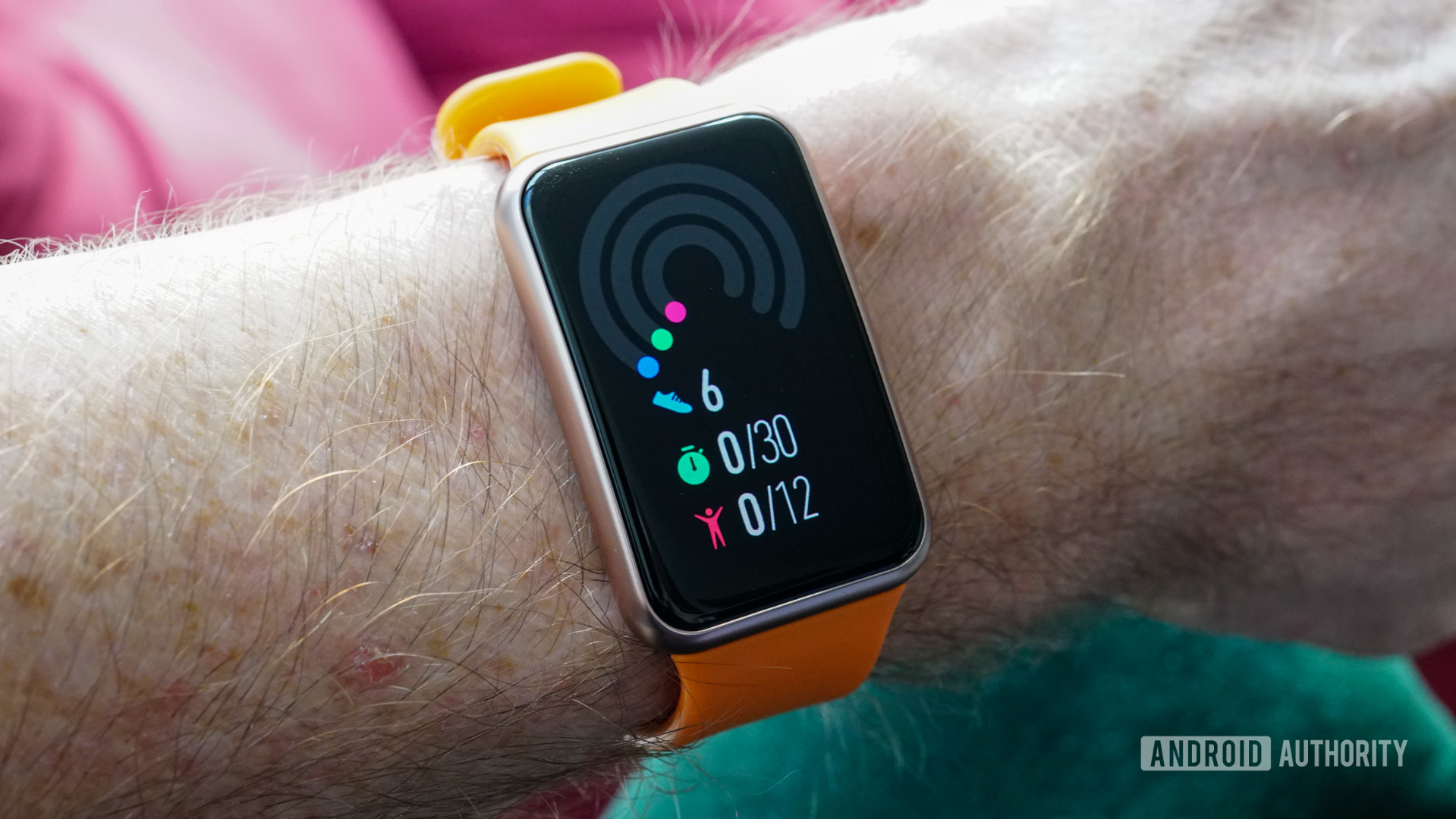
The Lite OS software experience on the Watch Fit will be very similar to anyone that’s used a HUAWEI Watch before. Swiping through the horizontal screens reveals heart rate, stress levels, weather, music playback, and an activity dashboard.
Unlike the Watch GT 2 Pro, you can only control music playing on your phone, not transfer it onto the Watch Fit. Considering both devices have 4GB of storage, I’m assuming this option isn’t available on the Watch Fit for battery life reasons. Or perhaps the new chipset powering the Watch Fit isn’t able to handle Bluetooth headphone connections. Or maybe just because there’s no speaker on the Watch Fit.
The same wearable software you're used to from HUAWEI Watches, reformatted to the narrower display.
The activity dashboard you can see in the photo above covers steps walked, minutes of tracked activity, and daily active hours in a simple progress-meter style. Some other watch faces can cram a bunch of this information onto the main screen if that’s more your thing. More detailed activity information can be accessed in HUAWEI Health which we’ll cover further below.
Pressing the single button on the side wakes the screen and takes you back to the home screen when you’re in a menu or app. Pressing it while on the home screen brings up the app picker with ready access to sleep info, SpO2 monitoring, breathing exercises, timers, alarms, and so on. Swiping from the left-hand side of the screen serves as your “back” button.
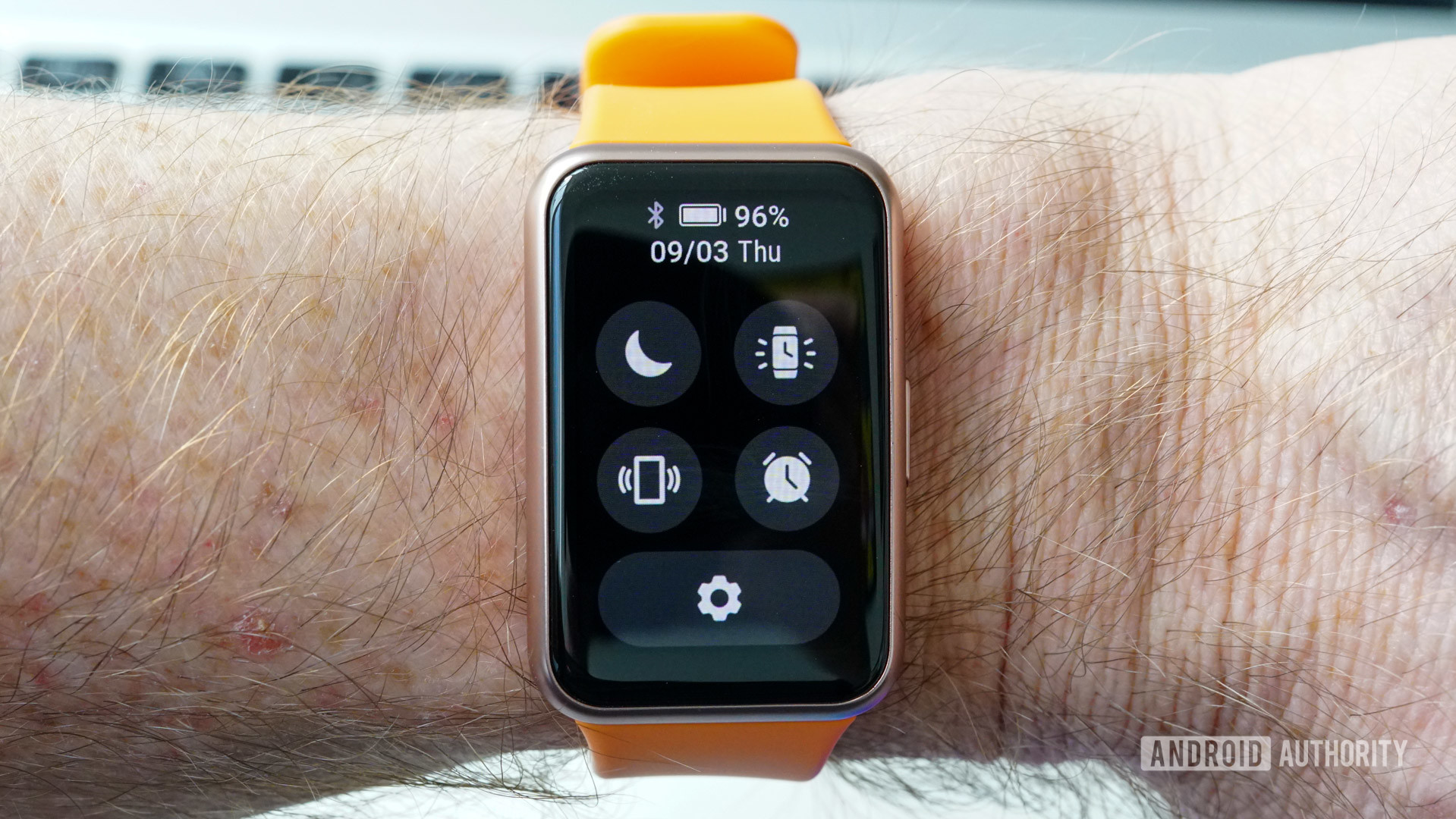
If you’re paired to a HUAWEI phone, you can use the Watch Fit as a remote shutter for the camera. I was impressed by how responsive this was. I expected a long delay between pressing the button on the Watch Fit and the phone taking the photo, but it was almost instantaneous.
Swiping up from the bottom edge brings up your list of notifications, which you can customize in the HUAWEI Health app. You can see two notifications at a time; tapping one opens the notification full-screen, displaying six lines of text which you can scroll through to continue reading. These are read-only, however, there is no reply functionality here.
Swiping down from the top of the home screen brings up “quick settings” shortcuts. These include a settings menu shortcut, do not disturb toggle, “show time” toggle, find my phone, and an alarm shortcut. You’ll also find your battery indicator here, along with a Bluetooth indicator and the date if it’s not already displayed on your watch face.
Read more: The best fitness trackers for women

The Settings menu, accessed by swiping down from the top of the home screen or via the app picker, is a pretty lean affair. You can change display settings like screen timeout or choose a new watch face, adjust the haptics, set do not disturb profiles, and disable auto-detect workouts. The default haptics are set to “strong,” which I like. The “soft” option pretty much just makes it a shorter buzz, or you can just turn them off entirely.
I’m already very familiar with Lite OS and the screen layout and navigation, so I quite liked the experience here. It’s worth pointing out for anyone unfamiliar with Lite OS that some parts of the software can be expanded if you go into them via the app picker.
For example, the main weather screen just shows the current temperature and daily minimum and maximum. If you go into the weather via the app picker though you can swipe up for hourly temperature changes and daily forecasts for the week ahead. Likewise, the activity dashboard on your home screen just shows the progress meter, but if you go into activity records in the app picker you’ll see the same dashboard but can also swipe up to reveal further information.
Activity and fitness tracking
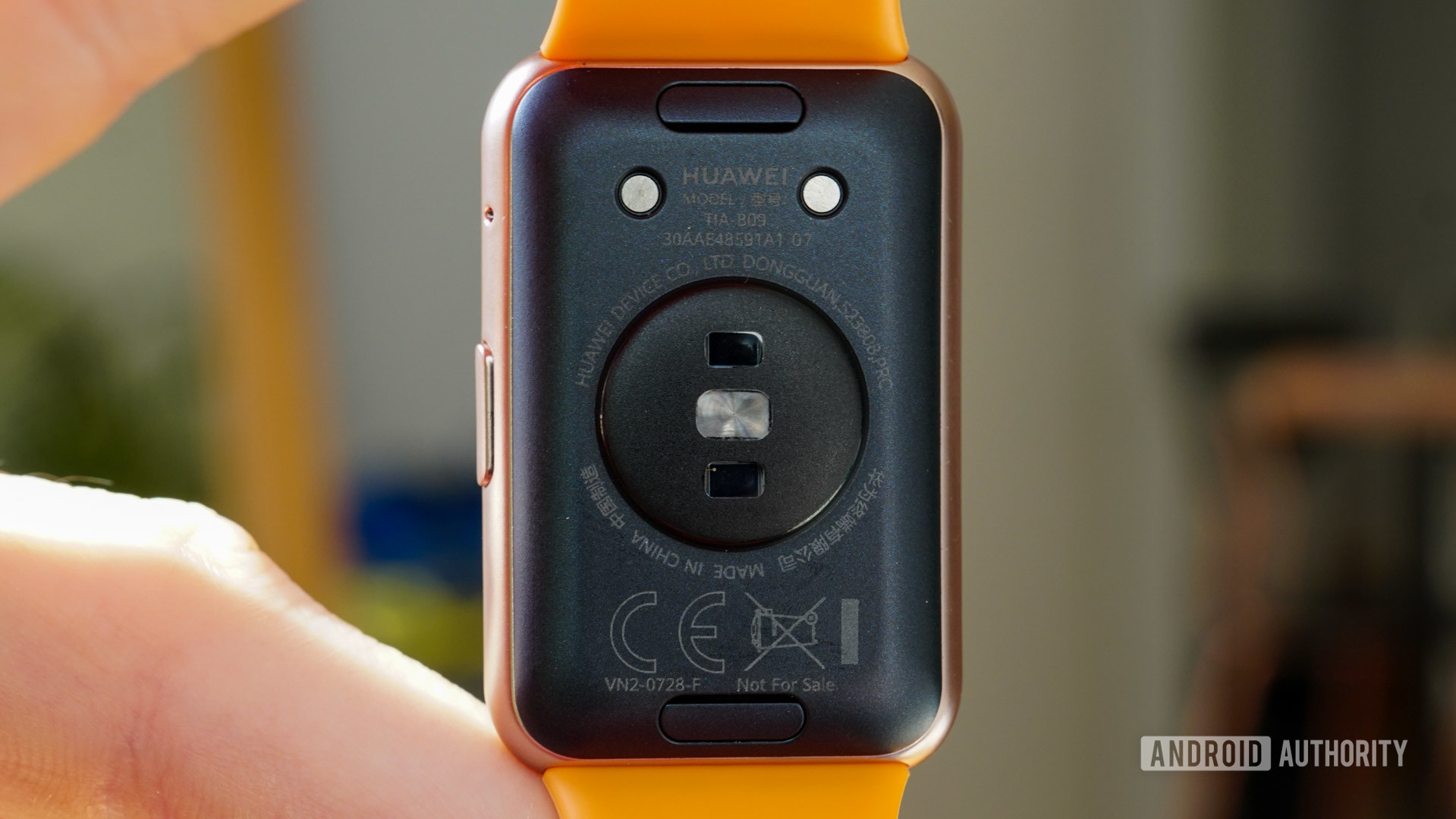
The HUAWEI Watch Fit tracks 96 different activities, including auto-tracking of walking, running, elliptical, and rowing. The Watch Fit will regularly remind you to get up and stretch when you’ve been inactive for too long — a feature I have finally overcome the urge to just ignore. This is just one reason it’s worth keeping the haptics on.
Other (manually activated) fitness tracking modes include indoor and outdoor running and cycling, hiking, running courses, indoor and open water swimming, and a lot more. (Just tap the “+Add” button at the bottom of the list to add other activities like yoga, HIIT, boxing, strength training, ballet, and martial arts to your quick access list.)
The HUAWEI Watch Fit has improved GPS for more accurate fitness tracking, which also means you don’t have to take your phone along on a run. Sadly, you won’t have the opportunity to listen to music stored on the watch with Bluetooth earbuds paired to it like with HUAWEI’s GT 2 series of watches. HUAWEI says you can get 12 hours of battery life out of the Watch Fit if GPS is running the entire time.
If you need a little extra coaching, there are a dozen animated fitness courses to guide you through some simple exercises. I tried a couple of these and I appreciated both the idea and execution. I can’t imagine most people will use them all that often but anything to help people get more active is worth it.
There’s also a menstrual cycle calendar you can add to your HUAWEI Health dashboard by tapping Edit at the bottom of the main dashboard screen.
The SpO2 monitoring is on-demand only. While HUAWEI claims the SpO2 measurements are “on par with professional equipment,” their own documentation states that the Watch Fit is not a medical device and should be used for reference only. This is a legal obligation regarding certification but still, the SpO2 tracking here is pretty rudimentary with no 24/7 tracking or sleep apnea alerts.
I've found HUAWEI's fitness tracking to be pretty good across the Watch series.
The Watch Fit is water-resistant to 5ATM, meaning you can safely take it in the pool. I’ve had some bad luck in the past with some smartwatches’ ability to accurately track laps swam, so I’ll be interested to see if the Watch Fit fares any better. Sadly I wasn’t going anywhere near a public swimming pool during the HUAWEI Watch Fit review period so I’ll have to hold out on judgment there.
In general, I find that HUAWEI’s fitness tracking is pretty good. The same is true here on the Watch Fit. I tracked a couple of bike rides, some walks (which the Watch Fit accurately auto-detected), and some strength training. With the Watch GT 2 Pro on my other wrist, the data matched very closely. The GPS route info and other recorded data were very accurate too.
All told, I was very impressed with the Watch Fit. Considering how poorly a “proper” smartwatch like the Samsung Galaxy Active 2 sometimes tracks activity, I was pleased to find the same high level of reliability of more expensive HUAWEI watches at such an affordable price point. From SpO2 monitoring to heart-rate, stress, or sleep, the Watch Fit did every bit as good of a job with fitness tracking as the Watch GT 2 Pro which costs almost three times as much.
Further reading: The best new wearables from IFA 2020
The ecosystem question
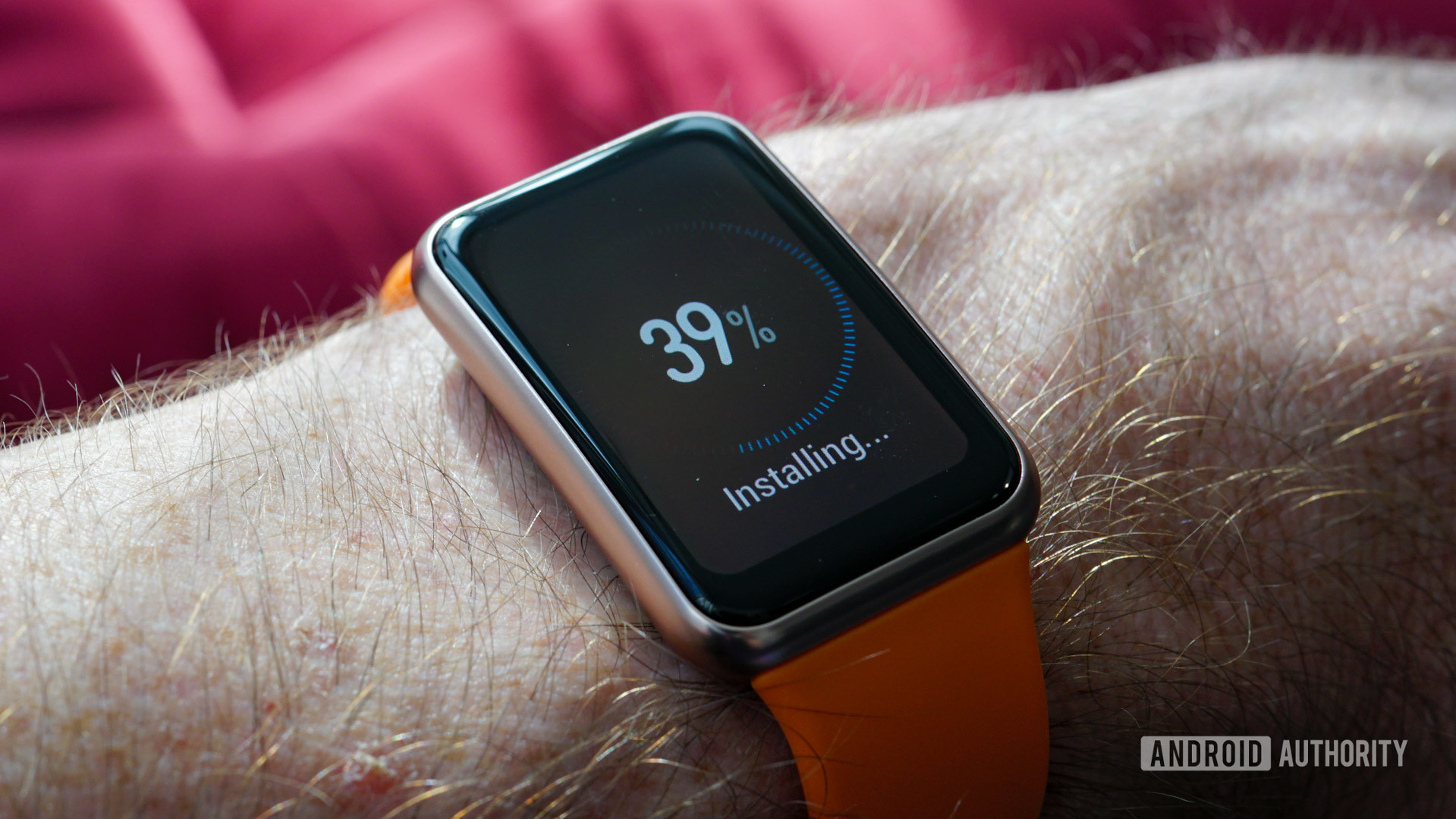
One thing that will be a deal-breaker for some is the lack of third-party app support. If you’re firmly embedded in the Strava ecosystem, for example, the Watch Fit is not for you. On other HUAWEI Watches I’ve used, you can data share with Google Fit, however, I couldn’t get that to work with the Watch Fit. A HUAWEI rep told me it “doesn’t support data sharing overseas,” presumably meaning outside China.
The Watch Fit pairs to your Android phone or iPhone via BT5.0/Bluetooth LE and has 4GB of storage. As mentioned above, you don’t have the option to load up your own music, nor can you pair earbuds to it. There is, of course, no NFC on the Watch Fit either, nor a speaker for taking calls.
Some basic features are not available if paired to an iPhone (like the stress test, music controls, or the menstrual cycle calendar), and other more advanced ones like remote shutter only work when paired to a HUAWEI device.
The Watch Fit naturally doesn’t offer quite as much functionality as a more expensive HUAWEI smartwatch but it still covers an awful lot of the basics, assuming you have a HUAWEI phone in the first instance or an Android phone in the second.
HUAWEI Watch Fit specs
| HUAWEI Watch Fit | |
|---|---|
Display | 1.64-inch AMOLED touchscreen |
Resolution | 456x280, 326 ppi |
Storage/CPU | 4GB ROM, DK3.5+ST |
Battery capacity | 180mAh (10 days est.) Pogo pin charger |
Sensors and components | Accelerometer Gyroscope Heart rate sensor (PPG) Ambient light sensor Capacitive sensor GPS+GLONASS Bluetooth 5.0/BLE Microphone |
Water resistance | 5 ATM |
Compatibility | Android 4.4+ and iOS 9.0+ |
Dimensions and weight | 46mm x 30mm x 10.7mm 34g (21g without strap) |
Material | Body: Polymer Strap: Silicone |
Value and competition
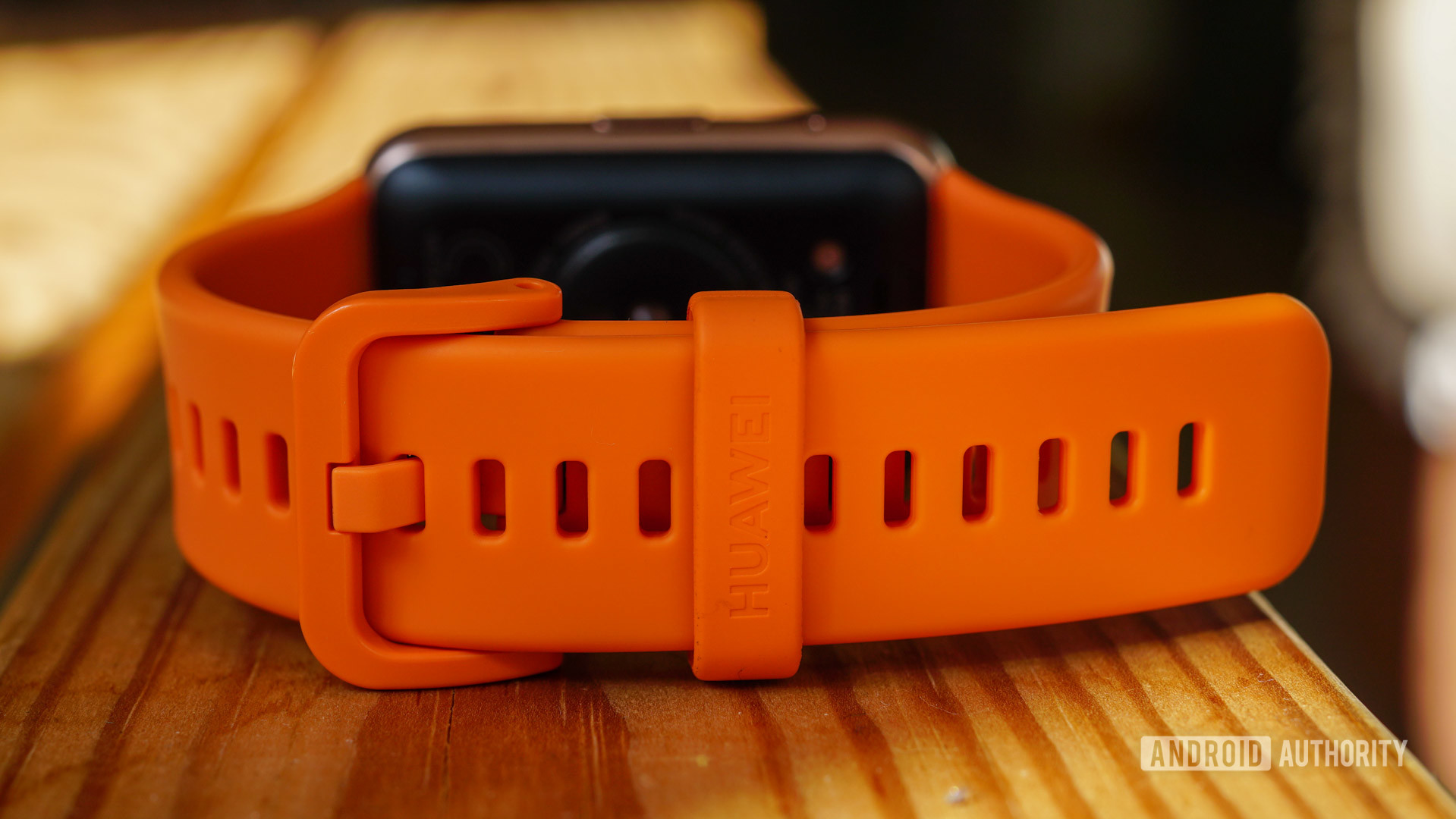
The HUAWEI Watch Fit price is currently listed at €129/£119 on HUAWEI’s website in Europe (the German site and Spanish site are offering a free body fat scale if you buy before October 2, 2020. HUAWEI France also has the HUAWEI Watch Fit for €129 but you can choose between two mini speakers, a pair of Bluetooth Headphones Lite, or the body fat scale as your bundled freebie. It doesn’t look like our friends in the UK are getting any gifts to sweeten the deal). The HUAWEI Watch Fit is available in all four colors in the UK and mainland Europe. You can also pick it up on Amazon.
At this price, the HUAWEI Watch Fit is pretty comparable to a lot of other fitness trackers and smartwatches, from the Fitbit Charge 4 and Samsung Galaxy Fit 2 to the currently discounted HUAWEI Watch GT 2e. I’d find it hard to recommend to an iPhone user due to the more limited functionality on even some basic stuff, but for any Android users I think it’s a steal. My biggest caveat would be make sure you know what Lite OS is and offers first before you dive in expecting a full-blown smartwatch experience.
